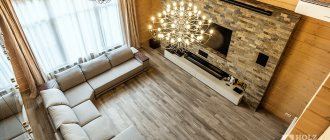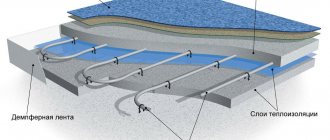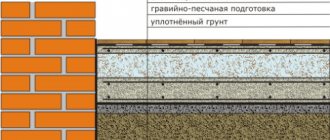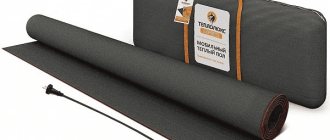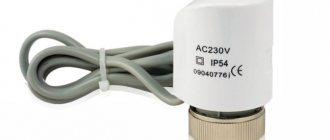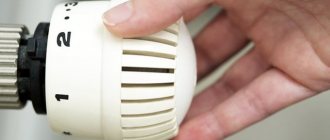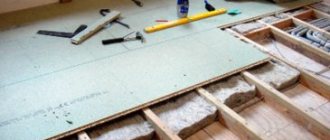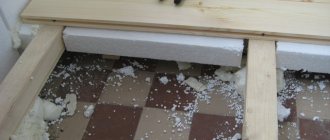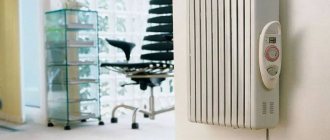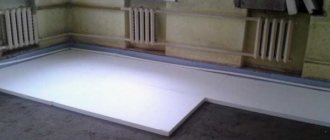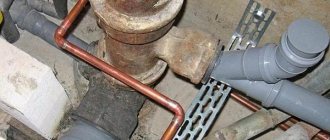Why is it profitable to make heated floors?
The main advantage of heated floors over all other types of heating is that they are hidden from view and are ideal for families with small children. In addition to the fact that babies can crawl safely, they will not get burned on heat sources that are securely hidden under the finishing coating. There are no drafts in the room where heated floors are installed.
Warm floors reduce heating costs in houses with very high ceilings, where it is difficult to rationally organize heating of the entire volume of the room. In apartments located on the ground floor, above damp, cold basements, heated floors will provide a comfortable microclimate.
In addition, they do not dry out the air, which is especially appreciated by sensitive people prone to allergies. When heated floors are an autonomous type of heating, they will help out on cold days in the off-season. Ceramic tiles, even with the best heating system, remain cold, and here the use of warm floors will help out.
Thus, the decision to install heated floors is for the benefit of the health of family members. It is important to choose which system is best to use.
When it comes to which type of heating is better, the debate continues: using liquid coolant or electric heating elements? These methods differ in cost and complexity of work during their installation and connection, and have their own installation and operational characteristics.
What systems are suitable for self-leveling floors?
There are three main heated floor systems that you can choose when arranging space heating. This:
electric, the main energy resource of which is electricity;
infrared, which works by converting radiation energy into heat;
water, where heat is transferred through heating and further movement of water.
All these systems have both disadvantages and advantages, and you must always choose carefully, taking into account the characteristics of the object that is to be heated.
Electric
High-quality and reliable self-leveling flooring in combination with warm electric floors is one of the most effective solutions when arranging heated flooring. Heating electrodes have a fairly small diameter, which allows the use of a relatively small amount of the mixture from which the corresponding coating is made. This means that installation costs, as well as further repairs and maintenance, will be relatively low.
It should be noted that this type of heated floor is the most popular among residents of post-Soviet countries. This is due to both the moderate cost of the structure and the ease of its installation.
Electric heated floors have a number of significant disadvantages. For example, if any element of the installation fails, then to dismantle and replace it you will need to remove the self-leveling floor at least partially. And these are unnecessary expenses, both financial resources and time.
Infrared
Warm floors, the operating principle of which is based on the use of infrared radiation energy, are characterized as the most productive system when taking into account thermal output. Another important advantage is that the thickness of such a floor is much less than an electric one, and even more so a water one.
This difference significantly affects the cost of installation/dismantling work and the cost of further maintenance.
A significant drawback is the price of the infrared version of heated floors. This is due to the relative newness of the product. Over time, the cost of the product will become more reasonable.
Water
Is it possible to combine a self-leveling floor with heated floors that use water as a coolant? How effective and expedient is this? It turns out that the issue here is quite ambiguous, and when choosing such a heater, all the nuances must be taken into account.
Firstly, the operation and maintenance of such a floor is much cheaper than electric and infrared ones. Secondly, it has high thermal efficiency.
But this is where the advantages end and the disadvantages begin. The fact is that a warm water floor has a rather bulky design. The tubes are quite thick and a large amount of solution is needed to fill them. On the one hand, this increases the cost of the system, on the other - the height of the fill.
Water floors: installation and operation features
Water floors are an economical type of heating due to the use of water as a coolant. After installing them, you don’t need to think about where to put the furniture. There will be no radiators on the walls, floors with a water circuit are not afraid of heavy interior items.
The main distinguishing feature of water floors is the difficulty in connecting them. For example, to install water heated floors in an apartment, you need a document confirming the consent of the management company to connect to central heating.
When the heating is individual, it is necessary to install a unit for heating the coolant. This means that all the difficulties associated with installing and servicing a boiler are added: gas, electric, solid or liquid fuel. You need to allocate a specific place for its installation, and at the same time comply with all the rules and regulations.
Installing a water circuit for a heated floor requires a lot of preparatory work. This is a rather labor-intensive process that requires attentiveness and professionalism, because in the event of a leak, you will have to open the entire finishing coating of the room.
Experts do not recommend leaving warm water floors as the main source of heat in houses where there is no good insulation of walls and windows. In addition, wall-mounted radiators would be more appropriate on landings or in small corridors.
Installation of heated and self-leveling floors
Installation of a heated floor begins with leveling the base for laying pipes.
Potholes are filled with cement mortar, and bulges are cut off with a hammer drill. After cleaning the base from dust and pieces of cement, it is primed. A heat reflector is lined on top. Foil works best. The edges of the foil sheets are overlapped one on top of the other; There is an allowance for the walls on the sides. A reinforcing mesh is laid out on top. After the preparatory work, the installation of plastic pipes begins. They are laid out in a zigzag so that one end of the system is connected to the heat supply source, and the other to the water inlet into the general heating system.
The distance between the pipes must be at least 10 cm. At bending points, the pipes are fixed with mounting tape using dowel nails.
Upon completion of the installation of the water heated floor, it is necessary to make a rough concrete screed. The solution should completely close all gaps, as well as the tops of the pipes. At the end of the work, you need to take a two-day break from work, let the cement set and dry.
Then a liquid self-leveling mixture is poured over the concrete coating. It should have a creamy consistency, thoroughly mixed.
The self-leveling floor under the warm one is poured starting from the farthest corner of the room. In order for the mixture to be distributed evenly, it is necessary to direct it with a staple. The surface is also treated with a needle roller. Thus, air bubbles are eliminated and any flaws disappear. The self-leveling floor for heated floors is ready 6 hours after pouring.
You should not turn on the heating system immediately after installation.
The structure of the flooring may be damaged. You need to let it dry completely for 2 weeks. After this, the floors can be painted.
Electric floors: pros and cons
Rooms with electric cables or heating mats installed in the floors are always warm and cozy. To obtain heat energy in this case, only electricity is needed. Electric floors are demanding for premises: they must comply with the standards for the installation of electrical appliances, that is, dry.
If with the water heating method the surfaces are heated unevenly, since they have time to cool down while running through the pipes, then electric ones are stable in this regard and provide heat evenly over the entire area.
But there are also disadvantages of heated floors. Electric floors are not always convenient to use. Many factors need to be taken into account: what kind of finishing coating will be in the room, how to arrange the furniture. Before installation of electric heated floors begins, a floor plan is drawn, which is then adhered to.
Electric floors come in film and cable types. The film is laid on a flat, clean subfloor under the finishing coating. Cable lines, by analogy with a water circuit, are filled with a concrete screed. By choosing any heating option, you can build warm floors in any house or apartment. There is a third method that combines the advantages of water and electric floors: liquid electric heated floors.
Electric or water heated floor: comparison
The main difference between an electric heated floor and a water heated floor is clear from the name and lies in the heating method.
- In the first case, elements are placed under the surface, which are heated by electricity and transfer heat to the floor.
- A water floor is a pipe made of metal-plastic or polyethylene through which hot water passes. This system includes a boiler and a control unit.
There are many differences between these two types of systems. We'll go through the main ones.
Important Features
To understand which heated floor to choose - electric or water, you first need to understand the main properties of these systems. It is important to understand that several systems fall under the general name “electric heated floor”. They differ in installation, price and operating principles.
There are two main types of electric underfloor heating:
- infrared;
- cable
In the first case, it is a carbon-coated film or carbon rods in mats. The floor is heated by infrared waves and transfers heat upward. These are the easiest systems to install.
Cable heated floors can look like individual wires or finished mats. Ready-made mats are much more convenient.
Cable systems are divided into:
- standard resistive
- modern self-regulating.
The latter are much more economical and have improved properties.
As a rule, conventional cable systems should not be installed under furniture, otherwise the cable may overheat and deteriorate. Self-regulating cables can be installed under the entire floor surface.
Safety
Obviously, water floors are safer. The worst thing that can happen to them is a leak.
Although installing an electric heated floor is relatively simple, an electrician must be involved in the process. Incorrect installation and connection of the cable can lead to minor and major electrical problems. It is recommended to make reliable insulation and provide grounding.
Another problem with cable heated floors is electrical radiation. Although its quantity does not exceed the maximum permissible values, it is believed that it does not have the best effect on health. Heating using infrared waves is called safer.
Reliability
Provided that the wiring meets all modern requirements, electric floors can last 30 years. But the water system will sometimes have to be repaired. Although the pipes themselves are durable, the various fittings and other connectors wear out over time and require replacement.
Therefore, when laying a water floor, they now try to install it without a screed, using special profile mats into which it is convenient to attach pipes.
What are liquid electric floors?
Consumers have already appreciated the advantages of the new generation of heated floors, which autonomously provide electric floor heating with a liquid coolant. It is not correct to call these floors electric-water, since the coolant is not water, but antifreeze. Therefore, it is correct to say “liquid floors”.
Liquid underfloor heating includes a set of polyethylene tubes filled with coolant. An electrical cable is inserted along the entire length of the tubes. When the electric heating is turned on, the coolant is heated by the cable and begins to release heat to the environment.
In various models of liquid heated floors, the coolant is antifreeze or distilled water.
Advantages and disadvantages of the capillary system
Compared to a conductor-based heating solution, capillary floors have several advantages. They do not have an electrical element inside the screed, so they can be installed in rooms with high humidity - baths, saunas, bathrooms. Also, the system connection diagram looks more attractive. But the capillary floor also has disadvantages:
- there is a problem of uneven heating of the floor, the temperature near the control unit (hot water inlet) is higher;
- for large rooms the heat transfer level of the capillary structure may not be enough;
- Although you can repair damage to the circuit yourself, you will still have to use specific components, coolant, and break part of the screed.
Based on the overall balance of characteristics, the capillary system can be considered as a reliable and efficient additional heating source. But in order to create comfort inside large rooms, it is recommended to use autonomous heat from the Korean company Daewoo Enertec or a classic underfloor heating structure powered by an induction electric boiler.
Advantages of liquid electric floors
The new form of heating compares favorably with its analogues in many respects.
The advantages of electro-fluid systems compared to conventional water systems are as follows:
- no need to connect to a heating boiler or central heating system;
- to perform its function, the coolant does not need the help of a circulation pump;
- installation is extremely simple: there is no need to build a collector and distribution board;
- the operation of the system is ensured by a very small amount of coolant, therefore, even if there is a leak, the apartment is not in danger of flooding;
- warm floors are heated as evenly as possible over the entire surface;
- much less labor is required when installing them, in contrast to water heated floors.
If we talk about the advantages over electric heated floors, then the following qualities should be noted:
- overheating of the cable, which is located inside the liquid, is excluded;
- Repairing liquid floors does not cause problems.
Add antifreeze or change electrical components through a convenient installation box. Damaged areas are identified instantly by wet circles on the screed. The heating effect ensures maximum floor heating due to the fact that the heat energy is stored not only under the screed, but also in the pipe.
There are certain advantages to liquid floors compared to infrared film floors:
- can be installed in rooms with any humidity, which is very important in many cases;
- Liquid floors can be installed under any floor covering.
There are currently two model ranges of electric water floors: XL Pipe and Unimat Aqua. The former are produced in Korea, the latter - in Korea and Russia. These models work on the same principle, but have their own design features.
Advantages of self-leveling floor
This type of flooring has undeniable advantages:
- Formation of a flat floor surface. The coating does not have seams and joints formed when pouring the screed, which acts as a base for most other types of flooring;
- Safety for humans. The mixture used to form the floor surface contains substances that are not harmful to human health. During operation, the self-leveling surface also does not emit toxic substances;
- Hypoallergenic. The surface of a self-leveling floor is smooth and without pores. Therefore, you do not have to be afraid of the accumulation of dirt or dust, which causes allergic reactions in people;
- Attractive appearance. The aesthetic value of such flooring remains consistently high. They are given any desired color. Modern technologies make it possible to create realistic 3D images on the surface, selected for each room depending on its purpose and stylistic design;
- High strength. Such floors can be used under conditions of increased mechanical impact caused by furniture or objects falling on the floor;
- High level of crack resistance. The special composition of the mixture being poured gives it plasticity and prevents shrinkage after hardening;
- Long service life. A floor covering formed according to all the rules will last at least 40 years, maintaining its presentable appearance throughout the entire period of operation;
- Chemical resistance. The self-leveling floor is resistant to a number of aggressive compounds;
- Fire resistance, allowing the formation of such a floor covering in premises for various purposes;
- Moisture resistance, allowing the installation of such flooring in rooms with high levels of humidity.
Floor with a unique pattern
XL Pipe: design and principle of operation
The xl pipe warm floor is arranged as follows. The coolant container is a system of thick-walled polyethylene tubes with a diameter of 20 mm. The coolant in this case is antifreeze (of a certain brand). The tubes contain a seven-core electrical cable made of chromium-nickel alloy, covered with a Teflon insulator.
The pipe is hermetically sealed at both ends. That is, there is no need for circulation of the coolant. The entire system warms up very quickly and as evenly as possible.
The energy consumption of the xl pipe underfloor heating system is 14.5 watt/m2.
One of the advantages of XL Pipe is that you can place furniture on top of the covering where they are mounted. Heavy objects will not cause harm, since installation is carried out under a five-centimeter cement screed.
The pipes are laid according to a special pattern. To regulate the temperature, install a thermostat and a temperature sensor. They are connected here in the same way as for other heated floors. However, you need a special thermostat, which is suitable specifically for liquid heated floors.
The manufacturer provides a 10-year warranty on the operation of its product. However, if the installation is done correctly, then such a system will last up to half a century.
Types of system. Device and principle of operation
Today on the heating equipment market in the underfloor heating segment, two models are presented:
- products of the Korean company Daewoo Enertec, warm water electric floors XL Pipe (XL Pipe);
- a product of the Korean company Caleo, capillary heated electric floor UNIMAT AQUA.
The latter option has domestic analogues, which are produced under license at Russian enterprises.
Both the first heating system and the second have some differences in the design and principle of operation of the heating elements, although everything else, both installation and principle of operation, are absolutely the same.
Warm electric water floors XL Pipe
Let's consider what is special about the design of a heating system using electricity. For a first acquaintance, let's take the heating system, electric water heated floors XL Pipe (XL Pipe). What is new in this case is the structure of the heating element itself. The base of a polyethylene pipe (walls 20 mm thick) is laid with a heating cable along its entire length. The important thing is that this is not a simple cable, but woven nickel-chrome threads enclosed in a Teflon sheath. The rest of the internal space of the plastic pipe is filled with liquid coolant, which is in a static state. The pipe is a hermetically sealed single circuit.
Obviously, in this case you don't need either a pump or a manifold. The diagram clearly shows the internal structure of the heating circuit, the appearance of the plastic pipe and an approximate layout of the XL Pipe electric water floor.
The coolant in this case is antifreeze, so the system should correctly be called an electro-liquid heated floor. Using thermal energy from heating the electrical element, the coolant is evenly heated along the entire length of the heating circuit.
Note: unlike traditional water floors, where the coolant in different parts of the water loop has different temperatures, the electro-fluid circuit guarantees uniform heating of the floor surface over the entire area.
The operating principle of the underfloor heating system in this case is based on the interaction of the heating element with temperature control sensors. The thermostat is one of the main devices for any heating system, so in this case you cannot do without it.
Electric water heated floors operate according to the following principle:
- The first is getting involved in work. The power provides heating to the electrical cable, which in turn heats the coolant surrounding it.
- The second is the expansion of the heated coolant. Due to the fact that the volume of liquid is small and the power of the cable is large, heating occurs intensively.
- The third is an increase in the volume of heated liquid, thereby creating increased pressure inside the plastic pipe (nucleate boiling).
- Fourth – quick access of the heated floor to operating heating modes.
Here it is worth saying a little about the costs of operating an electrical element associated with heating the coolant. Energy consumption in this case is 14.4 -15 W per square meter. meter of underfloor heating, which is significantly lower than what is required when operating conventional electric floors. Due to the coolant fluid, even a switched-off heated floor cools down two or three times slower than a cable heating system.
Capillary warm electric floor
Another version of electric water floors, capillary, is based on a different operating principle. Here lies the main difference between the system: the small diameter of the heating pipe, which is why this name arose. The plastic tube is connected to a small electric heating device, which is both an electric heater and a feeder for the entire heating circuit. The device controls the heating temperature, ensures heating of the coolant liquid and creates operating pressure in the system. As in the case of the first version of electric water heating equipment, this option is a closed, sealed system.
Note: the small diameter of the water pipe will require you to fill only 5-6 liters of distilled water, so to heat this amount of coolant, the power of an electrical appliance of 2.4 kW is sufficient.
It is better to install such a heating system through connecting an RCD and equipping the entire complex with an automatic device.
This combined floor heating system is designed for heating small spaces. The system can be installed in rooms whose area does not exceed 20 m2.
The advantages of the capillary heating system are as follows:
- wide functionality of the heating block;
- the presence of an antifreeze mode;
- automatic control of the heating temperature of the coolant depending on the indoor temperature;
- adjustment of the power of the heating device in the range of 0.1 - 2.4 kW.
- presence of a timer.
XL Pipe performance characteristics
In terms of its operational capabilities, the xl pipe electric water heated floor has several undeniable advantages:
- does not create an electromagnetic field;
- no need to install additional expensive equipment;
- there is no risk of system overheating;
- no negative impact on the finished floor covering;
- You can install furniture and heavy household appliances on top;
- it is possible to repair the system without the need to dismantle the finishing coating;
- savings in energy costs (20-30 percent less electricity required than with conventional electric floor heating);
- It’s not a complicated installation that you can do yourself.
Warm floors will warm your soul
"Warm floor" will warm the soul
Wherever you live, in a standard one-room apartment or a comfortable cottage, you still want to create maximum comfort and coziness of your own home.
One of the main indicators is the room temperature. This is especially true for gender. It is very unpleasant to step on cold tiles or parquet; you have to look for slippers or put on woolen socks. Thus, a cold floor creates a feeling of discomfort. To solve this problem, heated floors were created - “warm floors”.
Warm floors are the most convenient type of heating, which ensures uniform heating of the air. This is more profitable than conventional radiators, since the entire floor surface acts as a heating device. As a result, environmentally friendly heat is distributed throughout the entire perimeter of the room.
There are two types of underfloor heating: water and electric.
In a water heated floor system, the heating elements are metal-plastic pipes with circulating hot water. Heat transfer occurs from hot water to the floor, and from it to the heated room.
A water heated floor is more economical to operate, but more expensive to install compared to an electric one. However, we will consider the topic of the water system in detail next time, but for now we will study the electric heated floor and methods of its installation.
Despite the efficiency and durability of the electric cable heating system, it is not very popular with most consumers. This is explained by ignorance and fear of equipping your home with something very complex both in terms of installation and maintenance. However, this is a completely wrong opinion - in many countries of the world such technology is no longer “exotic”, but an ordinary reality.
The operating principle of this system is based on a special electrical cable, which is laid in the floor and, under the influence of a weak current, heats up, emitting heat.
The design resembles a multilayer sandwich. Below, thermal insulation, wire mesh, electrical cable and leveling solution are laid in turn on the concrete. The finishing coating for heated floors is a variety of materials: linoleum, parquet, laminate, carpet, and even natural stone or ceramic tiles.
As you can see, everything is quite easy, you just need to know a few simple rules . Here are the main ones:
- The cable for heated floors is not laid directly under the furniture.
- The base for the flooring must be dry and level.
- The heating cable is not shortened or lengthened. It is forbidden to cut it.
- The installation of the system must be thought out in advance, before the coating is laid.
- The heated floor is turned on only after the concrete has completely hardened.
Everything is clear with installation: economical, convenient, fast... It should be noted that the installation of heated floors is carried out both with and without a screed. Probably, many are scared off by the question of the safety of an unusual electrical installation. Don't worry, the shielded heating cable used meets all modern requirements, guaranteeing you absolute safety.
The press and other sources of information often talk about the harmful effects of electromagnetic fields on humans. However, we should not forget that heating cables meet all existing standards for electromagnetic radiation, otherwise they simply would not exist in Russia. Therefore, such “myths” can only be spread by people who are not familiar with the peculiarities of the system, but who want to “make themselves known loudly.” Remember that you have a microwave oven in your kitchen, and UHF sessions are held in the clinic, and you will understand that electromagnetic fields surround us everywhere, but there is no need to be afraid of them.
Now let's get back to the warm floor. Having talked about security, we cannot help but touch on its other advantages :
- Firstly, it is cost-effective . Optimal temperature distribution can significantly reduce heating costs, since traditional systems no longer heat the floor, but the space under the ceiling.
- Secondly, you don’t have to think about repairs and maintenance of the underfloor heating system - they simply aren’t needed! Once installed, a warm floor will last so long that you will become tired of it.
- Also, do not worry about the interior of the room . A cable system invisible to the eye will not harm your design at all, and a wall-mounted thermostat will only give your home a sophisticated taste of modernity.
Special thermostats for heated floors allow you to control the temperature automatically or manually. If desired, you can program the maintenance of a given temperature in the house or turn on the heating for a certain time.
The comfort with heated floors is obvious! You will be able to walk barefoot at home without fear of harming your health, you will be calm about the children playing on it, and you will maintain the natural humidity of the air.
Heated floors are used as the main or auxiliary heating system. The main (that is, the only) floor heating system is more suitable for individual construction of a cottage or country house, as it requires special design and calculations.
More often, this technique is used to complement an existing heating system. As an example, consider a children's room. You can open the window when the heating is on without fear of a draft, and turn it off when the temperature becomes optimal for the child. In addition to the temperature regime you program, it will become easier and more free to breathe in the room. Minimal heat flows do not cause dust particles to circulate in the air. For comparison: conventional radiators burn oxygen and dry out the air.
Warm floors are a godsend for residents of Khrushchev-era apartment buildings. These buildings are called “cool houses” because most of the heat escapes through thin walls. At the same time, it is useless to install such devices as radiators - they are “doomed” to work idle.
As you can see, the “warm floor” heating system has many advantages and advantages, being one of the most efficient and comfortable. With it you can implement any, the most diverse projects!
Price also plays an important role . Of course, a warm floor is more expensive than a regular radiator, but it also provides much more benefits. In this case, the total cost will depend on the area of the room where the system is installed. You don’t have to equip your entire apartment with heated floors; choose only the most necessary places for it (for example, the bathroom and toilet). This will significantly save your costs.
The most important thing is to remember that no matter how high the price may seem to you at first glance, it will still pay off over many years of operation.
How to install an XL Pipe liquid floor
Installation stages of electric water heating xl pipe:
- Prepare the rough base. They clear away debris, smooth out uneven areas, and seal cracks. Extruded polystyrene foam slabs are laid on the base. It plays the role of a heat insulator.
- The heat insulator is fixed using “umbrellas”. To do this, holes are made in the slab for fastening, and umbrella dowels are inserted there.
- A reinforcing mesh is laid on top of the heat-insulating slabs. Cell sizes from 100 to 200 mm.
- The mesh sections are tied together using metal tying wire.
- The heating cable from the heated floor kit is checked for resistance compliance.
- Then the pipes are laid out according to the diagram specified in the instructions. The tubes are fixed with plastic clamps to the reinforcing mesh.
- Connect the power cable from the thermostat to the junction box.
- The wires from the pipe are connected to the power cable. Terminals are usually used for this.
- Grounding cables are connected to the reinforcing mesh.
- Fix the temperature sensor at approximately a distance of 50 mm from the tube.
- Close the installation box. Seal the cracks with sealant.
- Then they make a concrete screed and wait for it to dry. Then a finishing coat is applied on top.
When installing XL Pipe electric water floors, the tubes must not be twisted or pinched. The work is carried out taking into account all the manufacturer’s recommendations. In winter, it is allowed to start the system at an average temperature to ensure the fastest drying of the concrete screed.
This system is expensive and must be handled with care during installation, avoiding tube fractures. The XL Pipe heating method is suitable for premises of any purpose: residential, office and industrial.
Preventative work on XL Pipe is carried out by specialists. As a rule, it is necessary to replace the coolant. This is done approximately once every 10-15 years. The final floor covering is not touched. This is a big advantage of XL Pipe over other systems.
The main disadvantage of this heating method is the rather high price of the system itself. However, the reliability, durability and heating efficiency of such heated floors justify these costs.
What is a self-leveling floor?
A self-leveling floor is a modern, high-strength coating. A self-leveling floor is a modern coating that has the following properties:
- Environmentally friendly material - thanks to the use of modern and, most importantly, natural materials for self-leveling floors, the coating does not in any way affect human health. And the absence of pores on the surface in which dust and dirt can accumulate, which can be allergens, is especially important for people suffering from this disease;
- Strength – after the mixture hardens, the floor covering can withstand significant loads. For example, the coating can easily withstand the fall of an object weighing 10 kg or more. For this reason, self-leveling floors are sometimes called “eternal coating”;
- Plasticity of the material - if the floor was poured correctly, cracks will never form on its surface. If we compare a self-leveling floor with a cement screed, then cracks will appear on the surface of the latter, even if the pouring operation is carried out perfectly;
- Durability - high-polymer flooring material has excellent performance characteristics and does not lose its appearance for decades, of course, with proper care.
For your information: Another undoubted advantage in the direction of self-leveling flooring is that such a coating is not only “gray mouse”, it can be in different colors or have a regular or 3D image on the surface. At the same time, the drawing can be chosen in any theme and stylistic direction, it all depends on your imagination.
If we discuss the negative qualities of self-leveling floors, we can highlight the following:
- High requirements for the quality of the foundation for pouring. To ensure that the self-leveling floor does not have defects, the base coating must be in perfect condition. Otherwise, the coating will have to be redone or it will not last long;
- Coolness of the surface. To the question “are self-leveling floors warm?”, unfortunately, the answer is no. They are quite cool, of course, much warmer than a concrete surface, but inferior to laminate or parquet. Therefore, it is necessary to lay an additional insulating coating on them or install a heating system inside the coating.
Choosing a heating system for self-leveling floors
Different types of floors have different installation methods.
First of all, before pouring the coating, you should choose the type of heating that is suitable for the self-leveling floor. After all, the quality and reliability of the future floor depends on the correct choice. Today, there are several systems to create a self-leveling heated floor:
Components for making a 3D floor: making the right choice
- Warm floors with water heating are the most famous type of heating, which can be called classic. “Is it possible to lay a self-leveling floor on a warm floor with water heating?” Yes, it is possible, but this procedure is not entirely advisable. The reason for this is the size of the pipe laid on the floor, because when pouring it, a large amount of leveling mixture is used. Since bulk material is not a cheap pleasure, repairs will cost a pretty penny. Also, the filling procedure will have to be carried out in several stages, because if you immediately pour thick material, the floor covering may turn out to be of poor quality and take a long time to dry;
- An electric underfloor heating system is the most suitable way to create a heated self-leveling floor. After all, heating electrodes, due to their small thickness, make it possible to reduce the consumption of bulk mixture to a minimum, and, as a result, the cost of repairs;
- Film-electric floor is the most modern type of heating. Thanks to the film elements, the heating system has more efficient heat transfer than the previous design. In addition, the thickness of the film is less than the electrodes, so self-leveling floor heating for a heated floor will cost even less than the previous one. But unfortunately, the film heating system, due to its novelty, is more expensive than a conventional electric one.
Important! You should know that a self-leveling floor for a warm water floor or an electric one will have a completely different installation system, and therefore the method of pouring the mixture, its quantity and the final price of the work.
What should you consider when installing heated floors?
Before laying the floors, determine the position of the furniture.
To create a high-quality and durable heating system under the self-leveling floor, you need to know all the technical aspects and small construction tricks. Compliance with technical measures will be the key to success when installing heated floors and will directly affect the service life of the heating elements.
- Furniture layout. First of all, before starting work you need to carefully distribute all the furniture around the room. According to construction requirements, heated floors are laid at a distance of at least half a meter from the walls. This is done in order to install furniture, because heating is not required under it, since in these places there will be minimal heat transfer.
Advice! Before self-leveling mixtures for heated floors are poured onto the heating system, it will not hurt to take care of a drawing for laying the elements of the heating structure. This drawing will be especially important when it is still planned to lay some communications in the room.
- Doorways. Laying heating through doorways is extremely undesirable, because when dismantling the door frame or repairing it, there is a high risk of breaking the underfloor heating system. And its restoration is a very complex and time-consuming process.
- Significant temperature fluctuations. Installing a self-leveling heated floor with your own hands is quite simple, the main thing is to know that these systems are afraid of sudden temperature fluctuations. Therefore, in places where there may be a sharp drop in temperature, for example, a balcony, hallway or other unprotected room, the underfloor heating system and walls should be additionally protected with insulation, this is especially important for water structures.
What will you need to install a self-leveling heated floor with your own hands?
Tools for pouring the floor
If you decide to independently install a heated floor system with subsequent pouring, then, first of all, you need to purchase the following materials:
- sand and cement for screed;
- reinforcing mesh. Metal is best;
- thermal insulation with reflector;
- mixture for creating a filler coating;
- fastening strip for tubes;
- dowel-nails 6x40 or 7x40.
It will also be important to acquire tools such as:
Which flooring to choose for the living room?
- drill;
- drill bits for concrete (have pobedite soldering). Accordingly, 6 or 7 millimeters in thickness;
- mixer attachment for a hammer drill or drill;
- regular or laser level;
- trowel and ladle for pouring the mixture;
- rule;
- needle roller and paint pads.
Important! Without these tools and materials, it is not recommended to install and fill it yourself; it is better to turn to professional builders.
We install self-leveling heated floors step by step
Priming the screed surface
To ensure that the self-leveling floor covering is of high quality and lasts a very long time, you need to follow the following sequence of actions:
- At the very beginning, the old floor covering is removed down to the base. After that, dust and other contaminants are removed with a vacuum cleaner (preferably a construction one). And when the surface is cleaned, all chipped holes, seams and other surface defects present are sealed with cement-sand mortar, and the surface is also primed;
Important! The primer improves the adhesive properties of materials and prevents moisture from penetrating into the concrete surface.
- After the screed has dried, a special heat reflector is placed on the floor. Most often, the reflector is made of foil mounted on a propylene base. Since this material is made in rolls, it is enough to roll it out over the floor surface, while making an overlap between layers and overlaps on the walls of at least 5 centimeters;
Important! The joints must be taped with tape.
Laying heating elements
- After laying the insulation, a reinforcing mesh is mounted on its surface and only after that can you begin laying the heating elements. According to the drawn up layout of furniture or plumbing units, heating elements or pipes are laid. A distance of 8-12 cm is maintained between them, after which the elements are fixed in front of the pipe bends or the edges of the electrodes using a mounting strip and dowel nails;
Important! The mounting strip must be placed on top of the heating pipes.
- Now it's time to pour the cement screed. If you don’t know how to make a rough screed correctly, you can read the separate article assigned to this question. The correct screed should be flush with the pipes or electrodes. After pouring, the screed should dry thoroughly. Depending on the thickness of the screed, the humidity of the mixture and the temperature in the room, drying time can range from 2 to 5 days;
Advice! To check whether the screed has dried or not, you can lay a piece of film measuring at least 1 square meter on its surface and secure it with tape around the edges. If after 24 hours no condensation has formed under the film, it means the screed has dried.
- After the screed has dried, its surface is primed and a self-leveling leveler for heated floors is poured. How to properly make a self-leveling floor can be read in a separate article; here we will indicate only the general rules for pouring. To fill, the mixture is diluted to the consistency of liquid sour cream, after which, using a wide spatula, you need to help the mixture spread evenly over the floor surface. Then the still uncured solution is rolled with a special needle roller to remove air particles from the bulk mixture. Thanks to the rapid polymerization of the material, the mixture completely hardens after 6-7 hours. You can move on the surface.
Pouring the mixture onto the floor surface
Important! Although the surface hardens in a short period of time, it still needs to settle thoroughly, so it is not recommended to turn on the heating system for 2-3 weeks. Otherwise, the self-leveling floor may become deformed or even peel off.
Features of the capillary heated floor Unimat Aqua
Liquid underfloor heating Unimat Aqua differs from XL Pipe in that the system does not consist of one thick pipe, but is equipped with many small diameter pipes. Hence the name of the system - capillary. It is connected to a device that has a power of 2.4 kW. In this way, the coolant is heated and heat is released. The whole system is closed. Installation of an additional heating unit is not required.
The coolant in the Unimat Aqua system is distilled water. It will require no more than 6 liters. The size of the heated area that one set can heat is approximately 20 square meters. How warm the room will be depends on the thermal insulation properties of the walls and ceilings. Warm floors very quickly create a comfortable indoor microclimate.
If necessary, several Unimat Aqua systems can be installed in one room. However, most often it is used to heat a small room. The service life of capillary heated floors is approximately 5 years.
Unimat Aqua comes in two types. Basic, which includes a control unit, an installation kit, and two pieces of pipe for connections. All this will be needed to form a small pipeline. The additional kit consists of a coil of small diameter tubes, which is enough to heat an area of 10 to 20 square meters. meters.
For installation, you need damper tape, tube fasteners and heat-reflecting material. After installation, the floors are filled with cement screed.
Advantages of a water heated floor with a conductor heater
If we compare the XL Pipe product and products with similar engineering implementation, the advantages of the heating system compared to classic heated floors are immediately noticeable.
- There is no problem of controlling the drop in outlet temperature, the circuit is heated evenly.
- There is no unpleasant property of heating the floor surface, so to speak, in the direction of water movement. In classic heated floors, supplying coolant to the circuit always implies first heating the areas closest to the entry point, and if the boiler power is insufficient, the room may warm up unevenly. The water electric floor is completely free of this disadvantage.
- There is no need to purchase collector combs, flow meters, control sensors, or circulation pumps. The system for monitoring and adjusting the temperature has also been simplified, so the cost of purchasing an electric water floor is noticeably lower.
Pros and cons of the Unimat system
The Unimat system is very smart. It is equipped with a multifunctional control unit that can adjust the room temperature or heating of the coolant to the desired level. You can also set the period and operating time of the system.
Unimat heated floors are highly safe. They are installed in rooms with any humidity (for example, in bath complexes).
The disadvantage of Unimat underfloor heating is that the heating of the floor is not uniform. This is due to the fact that the coolant comes from the heating block hot, then gradually cools down. That is, the disadvantage is similar to conventional heated floors with a water circuit.
Types of heating elements
Various types of heating structures are used to heat floor coverings. Each of them has its own installation and subsequent operation features, which are worth learning about in advance.
- A water circuit within which a heated coolant circulates. The pipeline is laid in the form of a snake or spiral. When performing installation in an apartment in a multi-storey building, difficulties will arise with connecting to central heating. To regulate the degree of heating, a collector unit is installed. Despite the high cost of installation, such a floor has minimal operating costs. When installing it, it will require pouring a sufficiently thick layer of mortar to prevent the pipeline from moving during operation;
- Electric heated floor, formed by laying an electric cable. Installation is carried out according to a certain scheme. The cable can be single- or double-core of varying power. To simplify installation, special bases are often used. Manufacturers offer ready-made electrical mats, in which a cable of a certain power is initially laid with a predetermined pitch. In this case, installation consists of simply laying the finished product on a carefully prepared base. A thin layer of mortar is used to fix the mats. The thermostat included in the system allows you to control the degree of heating of the floor covering;
- Thermal film. Allows you to avoid using a thick screed. Scotch tape is used to secure the thermal film. Maintain the temperature at the specified level.
Installation of floors with ready-made mats
How to install Unimat Aqua Caleo underfloor heating
Installation of Unimat Aqua electric water floor heating is carried out as follows:
- Preparing the rough base is the same as for XL Pipe: cleaning, removing uneven surfaces.
- Prepare a place on the wall for the thermostat.
- A groove for the temperature sensor is made on the rough base.
- Heat-reflecting plates are laid out. They are fastened together with staplers.
- From the side where the thermostat is located, they begin to lay out the Unimat Aqua.
- When laying out the system, in the places where the mat is rotated, one of the connecting wires is cut, and the mat is turned 180 degrees. The tubes should not touch or intersect. The power wire is cut strictly in the middle. The maximum permissible strip length is 25 meters.
- The entire system is carefully glued with tape to the heat reflector.
- Mounting wires connect the mats. This is done as follows: the ends are stripped and sleeves are installed, which are clamped with pliers.
- Heat-shrinkable tubes are placed on the wires. The power cable is spliced with the connecting cable.
- The system is connected to the thermostat according to the diagram that is attached to this device.
- To connect the concrete screed to the subfloor, small through holes are cut into the heat reflector.
- A temperature sensor is installed along the rods, previously laid inside the corrugated pipe.
- Checking how the Unimat Aqua works.
- If the tubes have warmed up within 15 minutes and no failures have been identified, the heated floors are filled with concrete screed.
Liquid electric floors are an excellent source of comfortable heat. They can become either a primary or an additional heating device and will perfectly cope with their function in any room.
Water heated floor on a polystyrene basis
Another option for the design of a water heated floor with a liquid coolant is the installation of pipes in special slabs with grooves made of foamed polymer. By the way, we have already written in this article about what components are needed for a water heated floor.
To compensate for thermal expansion, such plates contain deformable plates. It is recommended for use in light buildings with limited load on the floors.
Heated floor on polystyrene base
As in the case of a heated floor with a screed, the first step is to lay thermal insulation on the main floor.
After this, the slabs are laid on the thermal insulation. Laying occurs starting from the corner of the room. Polystyrene slabs have special grooves into which coolant pipes are laid.
Polystyrene boards for water floors
After installing the piping system, connect the heating circuits to the manifold and test the system, and then you can begin laying the subfloor, such as chipboard or gypsum fiber board, and then the finishing floor covering, such as tiles.
This is what the schematic diagram of a warm water floor on polystyrene slabs looks like
1. Finish floor covering, 2. Thermal insulation layer 3. Coolant pipeline 4. Compensation plates made of aluminum 5. Polystyrene plates with grooves for pipes 6. Floor covering
Floor on polystyrene boards
